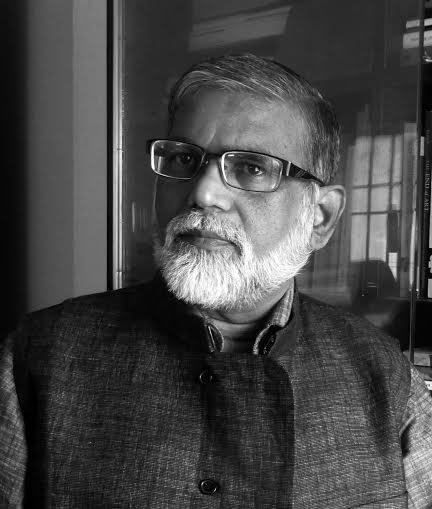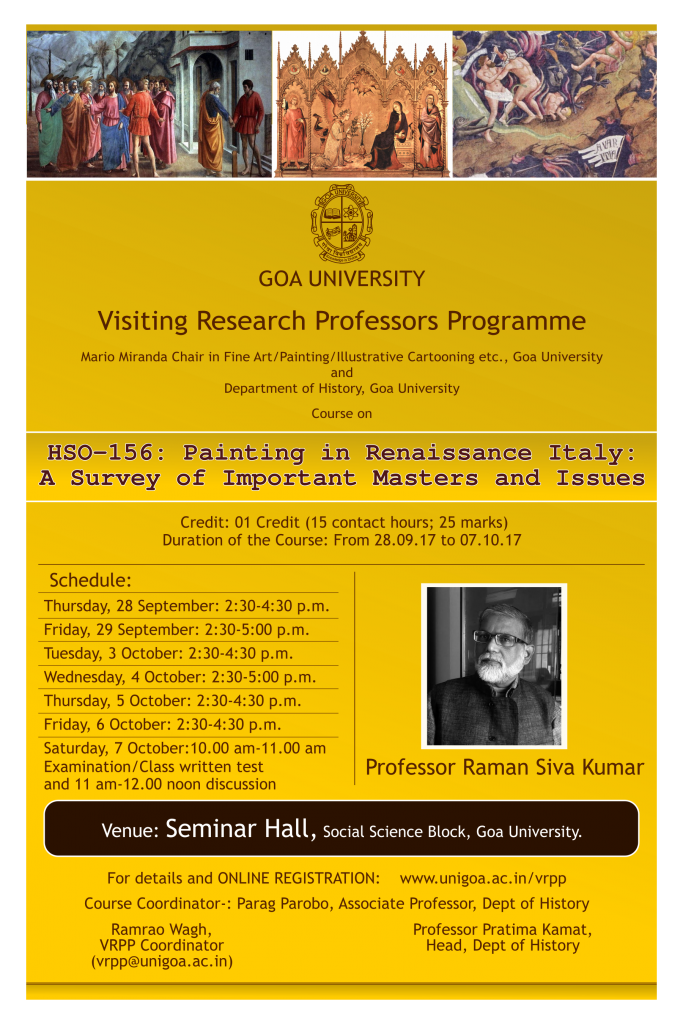HSO-156 Painting in Renaissance Italy: A Survey of Important Masters and Issues by Professor Raman Siva Kumar Mario Miranda Chair Professor in Art, Painting and Illustrative Art, Cartooning
-
GOA UNIVERSITY
Visiting Research Professors Programme
Mario Miranda Chair in Fine Art/Painting/Illustrative Cartooning etc., Goa University
and
Department of History, Goa University
Course on
HSO-156 Painting in Renaissance Italy: A Survey of Important Masters and Issues
Credit: 01 Credit (15 contact hours; 25 marks)
From 28th September to 07th October 2017
Venue: Seminar Hall, Social Science Block
By
Professor Raman Siva Kumar
Mario Miranda Chair Professor in Art, Painting and Illustrative Art, Cartooning
Goa University
(Internationally noted contemporary Indian art historian, art critic, and curator)
Schedule:
Thursday, 28 September: 2:30-4:30 p.m.
Friday, 29 September: 2:30-5:00 p.m.
Tuesday, 3 October: 2:30-4:30 p.m.
Wednesday, 4 October: 2:30-5:00 p.m.
Thursday, 5 October: 2:30-4:30 p.m.
Friday, 6 October: 2:30-4:30 p.m.
Saturday, 7 October: 10:00-11:00 p.m: Examination/Class written test followed by discussion from 11 to 12 noon
The course is open to PG students and Research Scholars of Goa University.
Members of the general public are welcome to attend.
CLICK HERE TO REGISTER FOR COURSE
Course Coordinator-: Parag Porobo, Associate Professor, Dept of History.
SYLLABUS
Course: HSO 156- Painting in Renaissance Italy: A Survey of Important Masters and Issues Credits: 01 (15 contact hours; 25 Marks)
Course Instructor: Raman Siva Kumar, Professor in History of Art, Kala Bhavana, Visva–Bharati University, Santiniketan and Visiting Research Professor, Mario Miranda Chair, Goa University.
Objectives: The course will explore the art of Renaissance Italy from 1300-1564. Although the lectures will revolve around a selected number of masters of the period, the theme, underlying concepts, and their visual rendering, a number of broader concepts regarding the period will also be discussed.
- Introduction to Renaissance Art: Historical circumstances that lead to the emergence of the Renaissance, the distinctive characteristics of Renaissance art, Vasari the historical model for its study.
- Early Renaissance : Giotto, Jan van Eyck, Simone Martini and Ambrogio Lorenzetti: The nature of narration in Giotto’s paintings, Jan van Eyck and an alternate approach to realistic representation, a brief consideration of the secular themes in early Sienese painting.
- Fifteenth Century: Masaccio, Fra Angelico, Botticelli, Piero dell Francesca, Mantegna: A consideration of the construction of visual language, embodiment of religious piety, symbolism, pictorial order, and illusionism in 15th century Italian painting.
- Leonardo da Vinci: An exploration of Leonardo’s multi-faceted work, and a consideration of his major paintings.
- Michelangelo: A chronological exploration of the major works of Michelangelo, and the ides underlying them.
- Raphael: A chronological exploration of the major works of Raphael, and their place in the Renaissance canon.
- Giorgione and Titian: Giorgione and Venetian painting, Titian and the exploration of colour
- Mannerism: Crisis and Subjectivity: The end of Renaissance and the seeds of a new beginning.
Evaluation: ISA of 10 marks in the form of assignment to be submitted and SEA of 15 marks of one hour duration.
Suggested Readings:
- Baxandall, Michael. Painting and Experience in Fifteenth Century Italy: A Primer in the Social History of Pictorial Style. Oxford: Oxford University Press, 1972.
- Gombrich, E. H. Norm and Form: Studies in the Art of the Renaissance. London: Phaidon Press, 1966.
- ––––––––. The Story of Art. London Phaidon Press, 1995.
- Michael, Levy. High Renaissance: Style and Civilization. New York Penguin Books, 1975.
- Paoletti, John T and Gary M Radke, Art in Renaissance Italy. London: Laurence King Publishing, 2011.
- Stokstad, Marilyn and Michael W Corthren, Art History. New Jersey: Prentice Hall, 2011.
Biodata of Prof. Raman Siva Kumar
Raman Siva Kumar (born 3 December 1956), well known as R. Siva Kumar, is an internationally noted contemporary Indian art historian, art critic, and curator. R. Siva Kumar’s major research has been in the area of early Indian modernism with special focus on the Santiniketan School. He has written several important books, lectured widely on modern Indian art and contributed articles to prestigious international projects such as the Art Journal, Grove Art Online or The Dictionary of Art, Oxford University Press. Siva Kumar was born in Kerala. After completing his early education in Pune and Kerala he moved to Santiniketan, where he joined Kala Bhavan and completed his MFA in history of art. and Since 1981, Professor Siva Kumar, who is often considered to be “the most erudite and self-effacing art historian” of his time, has been teaching art history at Kala Bhavana, where he has held several offices, including that of the Principal. He was awarded the Kesari puraskaram for art writing by the Lalit Kala Akademi, Kerala in 2010. He served as a curatorial adviser for “Rhythms of India: The Art of Nandalal Bose”, curated by Sonia Rhie Quintanilla for the San Diego Museum of Art, USA. He also has co-curated an exhibition titled “Tryst with Destiny” for the Singapore Art Museum to mark the 50 years of Indian Independence. His writings on Abanindranath Tagore and the Santiniketan artists have contributed a new perspective on them by shifting the critical focus from nationalist revivalism to a context sensitive modernism. Among his curated exhibitions “Santiniketan: The Making of a Contextual Modernism” commissioned to mark the fifty years of Indian independence, “Benodebehari: A Centenary Retrospective” (co-curated with Ghulam Mohammed Sheikh) and “The Last Harvest : Paintings of Rabindranath Tagore”, commissioned to mark the 150th birth anniversary of Tagore are considered landmark exhibitions. The reputed Indian Magazine, Frontline reported, “The best show was the one (celebrating 50 years of Indian Independence) curated by R. Siva Kumar of Santiniketan, ‘The Making of a Contextual Modernism’, exhibiting about a hundred works each of Nandalal Bose, Rabindranath Tagore, Ram Kinker Baij and Benode Behari Mukherjee”. While “The Last Harvest : Paintings of Rabindranath Tagore”, was shown at ten major museums of the world including the Museum of Asian Art, Berlin; Asia Society, New York; National Museum of Korea, Seoul; Victoria and Albert Museum, London; The Art Institute of Chicago, Chicago; Petit Palais, Paris; National Gallery of Modern Art, Rome; National Visual Arts Gallery, Kuala Lumpur; McMichael Canadian Art Collection, Ontario; and National Gallery of Modern Art, Delhi. In 2013, he was awarded by the Paschimbanga Bangla Akademi for his book “Ram Kinkar Baij – A Retrospective”. R. Siva Kumar has also received a special award from the University of Dhaka for his contribution to the Indian art scene.
Ramrao Wagh, Professor Pratima Kamat,
VRPP Coordinator Head, Dept of History
For course details and ONLINE REGISTRATION: www.unigoa.ac.in/vrpp Email : [email protected]











